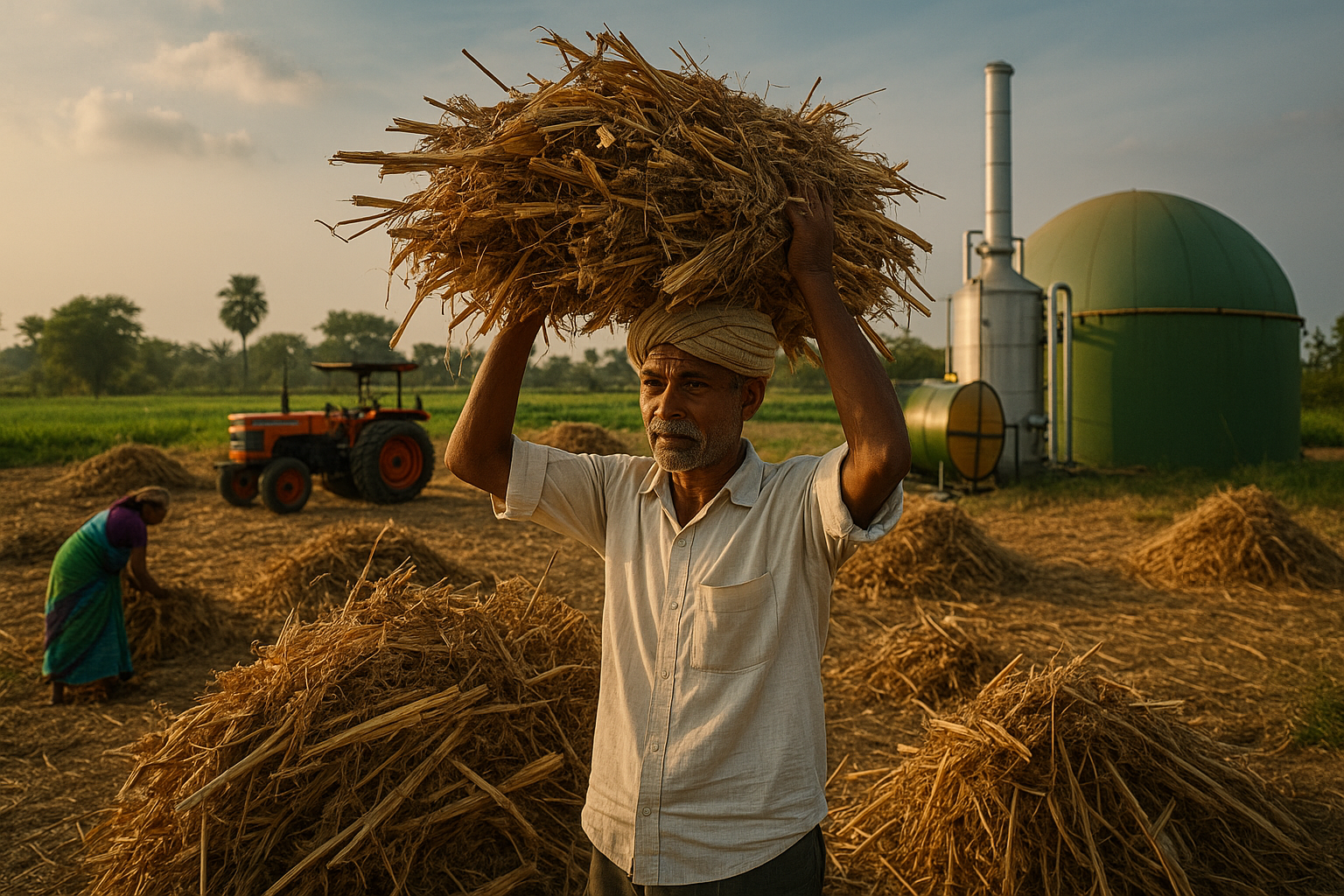Transforming India’s Agricultural Waste into Green Energy and Sustainable Wealth
The study by IIT Kharagpur and the University of Leeds highlights how India can transform its vast agricultural waste into renewable energy and valuable products through technological innovation, policy reform, and circular bioeconomy strategies. It emphasizes that sustainable waste management can reduce emissions, enhance rural livelihoods, and drive India’s transition toward a green and resilient future.

Research by researchers from the Indian Institute of Technology Kharagpur and the University of Leeds presents a detailed assessment of India's agricultural waste problem and the innovations driving its transformation into a sustainable resource. Authored by A.S. Reddy, Vara Prasad Kasa, Biswajit Samal, Brajesh Kumar Dubey, Vinay Yadav, and Daya Shankar Pandey, the study explores how India, generating over 500 million tons of crop residues annually, can turn this liability into an asset for clean energy, soil regeneration, and rural livelihood creation. The researchers point out that agriculture contributes nearly 13.7 percent of India's greenhouse gas emissions, and residue burning remains one of the most polluting agricultural practices. They propose that a combination of technological advancement, policy reform, and social participation can help India move toward a circular bioeconomy model, turning agricultural waste into a key pillar of sustainable development.
The Burden of Residue: An Overview of India's Waste
India's agricultural landscape is dominated by crops such as rice, wheat, maize, and sugarcane, which together account for the majority of crop residues. Northern states, particularly Punjab, Haryana, and Uttar Pradesh, generate the highest volumes of rice and wheat straw, while southern states contribute through sugarcane and horticultural waste. The paper also includes livestock manure and agro-industrial by-products like press mud and husks, which add significantly to India's waste load. Although traditional practices such as composting and feeding residues to livestock have sustained small-scale recycling, open-field burning remains pervasive because it is cheap and time-efficient. This practice releases massive quantities of CO₂, methane, and particulate matter, worsening air pollution and climate change. The researchers emphasize that effective utilization of these residues could create value-added products while mitigating emissions.
Policy Efforts and Implementation Gaps
The paper evaluates India's policy framework, highlighting initiatives like the National Policy for Management of Crop Residue (2014), the Crop Residue Management Scheme, and the SATAT (Sustainable Alternative Towards Affordable Transportation) program launched in 2024. These initiatives encourage both in-situ residue management and ex-situ valorization through bioenergy and biogas projects. Subsidies for technologies such as Happy Seeders, balers, and composting equipment have increased adoption rates, but challenges persist. The study criticizes fragmented governance and weak coordination among central, state, and local bodies. In contrast, China's large-scale straw-to-energy projects and the European Union's circular economy policies serve as examples of integrated systems. The authors urge India to adopt decentralized waste management, stronger private-sector participation, and region-specific strategies to ensure long-term impact.
Innovation at the Core: New Uses for Old Waste
A major contribution of the study lies in its discussion of technological innovations. It identifies three main valorization routes: thermochemical, biological, and material-based conversion. Thermochemical processes, such as pyrolysis, gasification, and combustion, can convert crop residues into bio-oil, syngas, and biochar, helping generate renewable energy while improving soil health. Biological pathways, including anaerobic digestion and fermentation, yield biogas, bioethanol, and biofertilizers, with recent advancements in microbial engineering improving process efficiency. Material-based valorization, an emerging trend, converts agricultural residues like rice husk ash, wheat straw ash, and bagasse ash into construction materials, reducing costs and lowering carbon emissions. The paper notes that such innovations can significantly enhance rural income and employment while supporting India's clean energy transition.
Barriers, Opportunities, and the Way Forward
Despite its promise, sustainable agricultural waste management in India faces several hurdles. Technical limitations, such as poor collection systems and feedstock inconsistency, reduce efficiency, while economic barriers, like high capital investment, hinder widespread adoption. On the social front, a lack of awareness and deeply rooted practices of burning slow the transition. Policy fragmentation and dependency on subsidies further complicate implementation. The authors advocate for an integrated approach that aligns technology, policy, and social change. They recommend the use of AI, GIS, and remote-sensing tools for residue mapping and resource planning, coupled with region-specific techno-economic assessments. The paper also calls for public–private partnerships and farmer cooperatives to ensure a steady feedstock supply and financial stability for waste-to-energy projects.
From Pollution to Prosperity
The study reframes agricultural waste as a cornerstone of India's sustainable future. Through the synergy of innovation, supportive governance, and community participation, agricultural residues can power a new green economy, providing renewable energy, sustainable materials, and environmental protection. The researchers stress that a national movement toward waste valorization could cut emissions, create millions of rural jobs, and establish India as a leader in bio-based sustainability. Agricultural waste, they argue, is no longer a byproduct of farming but a catalyst for climate resilience, rural prosperity, and industrial innovation.
- FIRST PUBLISHED IN:
- Devdiscourse
ALSO READ
-
ReNew Energy Secures $331M for Major Clean Energy Project
-
Scaling Green Investments: How Guarantees Drive Clean Energy Growth in EMDEs
-
Singapore Eyes Clean Energy Ventures with India
-
India and South Korea Forge Path to Advanced Manufacturing and Clean Energy
-
Adani Solar's Record Breaking Shipment Fuels India's Clean Energy Ambitions








